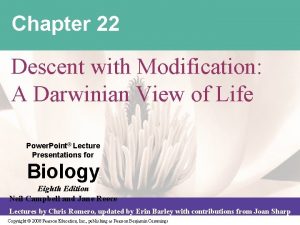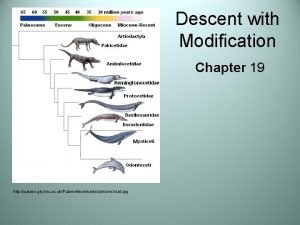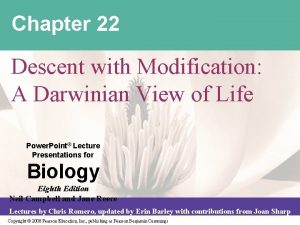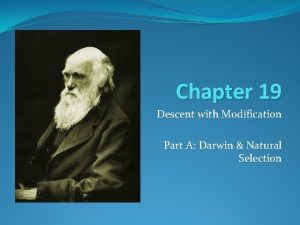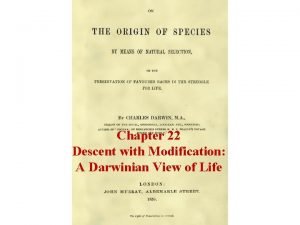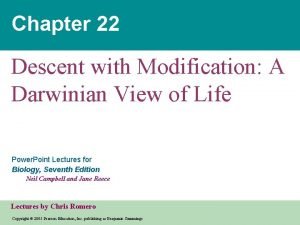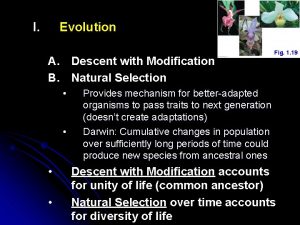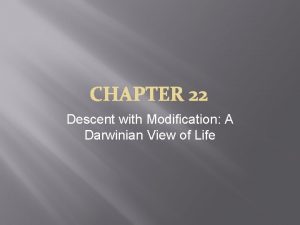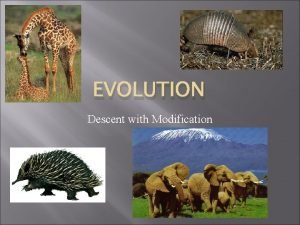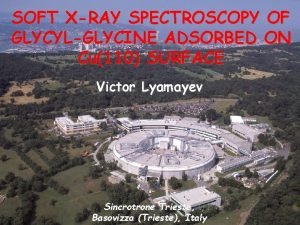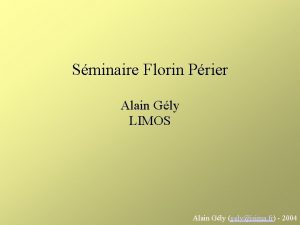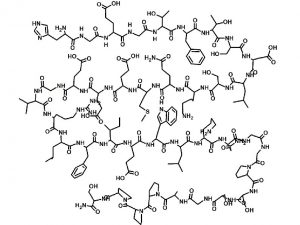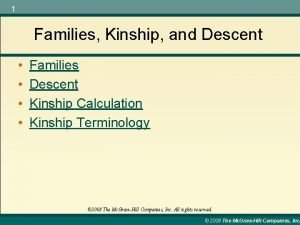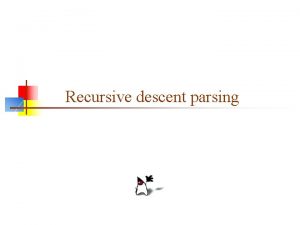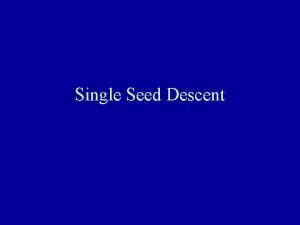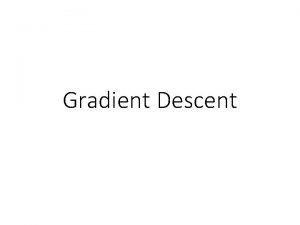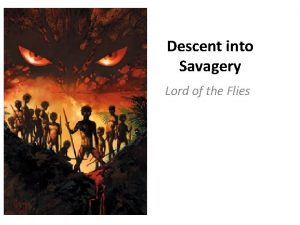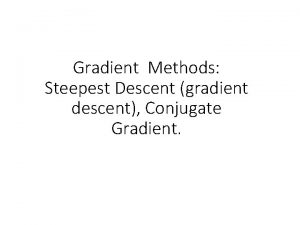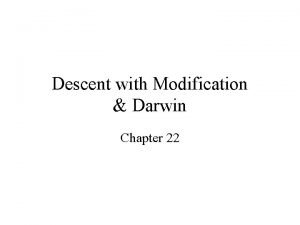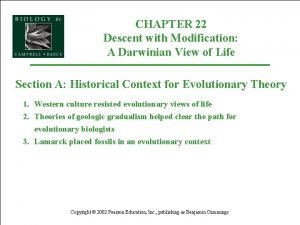Descent with Modification Chapter 19 http palaeo gly


















- Slides: 18

Descent with Modification Chapter 19 http: //palaeo. gly. bris. ac. uk/Palaeofiles/whales/pictures/clad. jpg

Evolution • Change over time in the genetic composition of a population – Individuals do not evolve • Natural Selection – the mechanism by which evolution occurs • Evolutionary adaptation – result of natural selection – increase in frequency of traits in a population

Darwin • Published Origin of the Species in 1859 • Common ancestor – All modern species descend from ancestral species that were different • Natural selection – Population will change from generation to generation, those who are best fit for their environment will go on to live and reproduce

Precursors to Darwin • Aristotle – species were fixed and unchanging • Linnaeus – classified diversity – taxonomy – Binomial nomenclature – genus and species • Hutton – gradualism – slow and continuous change • Cuvier – catastrophism – each boundary in layer represents change – Opposed gradualism • Lyell – uniformatarianism – changes in the present occur at the same rate as the past – Modern geology. . AP Bio 15 -16Evolution19_03 Grand. Canyon_SV. mpg – Lamarck – Acquired characteristics – Characteristics gained during an organisms lifetime are passed to offspring: Incorrect, your scars don’t show up in your children – Ex: giraffe • Wallace – developed a similar theory of natural selection as Darwin

Darwin’s Studies • HMS Beagle • South American coastline – Noticed organisms resembled European species in similar climates • Galapagos Islands – Studied finches and noticed many similarities with key differences in many species of animals – Common ancestor

Origin of the species • 1. Descent with modification – All organisms are related from an ancestor in the remote past – Similar to a tree – more similar species have a common ancestor in the nearer past. – 99% of species that have ever lived are now extinct not all common ancestors are still alive. • . . AP Bio 1516Evolution19_05 Galapagos. Islands_ SV. mpg Trypanosoma: Protist that causes sleeping sickness (fatal w/out treatment)

Origin of the Species • 2. Natural Selection – All species would increase exponentially in size if all organisms that were born reproduced and all offspring survived to reproduce. – Populations tend to remain stable in size. – Resources are limited. • Competition for resources occurs – Organisms within a population demonstrate variation. – Most variation is heritable. • Individuals who inherit favorable traits for their environment are more likely to survive and reproduce. • Unequal reproduction leads to a gradual change in a population toward favorable traits.

Natural Selection • Differential success and reproduction among individuals that vary in their heritable traits based on environment • Creates adaptations of organisms to their environment • If the environment changes new adaptations may arise through mutations or previous characteristics become advantageous in the new enironment: possibility of speciation • Acts on populations NOT individuals • Only affects heritable traits • Environmental factors vary from place to place not all adaptations are favorable in all environments.

(a) A flower mantid in Malaysia (b) A stick mantid in Africa Figure 22. 11

Evolution in Action • Introduced Plant species • Soapberry bugs beak length changing in response to a chance in the food supply • (pg 373)

Evolution in Action • Bacterial Antibiotic Resistance • Natural variation in the bacteria allowed them to survive in the presence of the antibiotic = reproduction of resistant popluations

Fig. 28 -03 l Ameoba: single celled protist Endocytosis 100 µm

Evidences for Evolution • 1. Paleontology • Fossils – remains or traces of organisms from the past. – Found in sedimentary rock • Igneous and metamorphic involve heat so living organisms don’t remain long enough to preserve – Older fossils found in lower layers (strata) – Biogeography – geographic distribution of species • Closely related organism are found in the same geographic regions

Evidences for Evolution • 2. Homologous Structures – comparison of similar structures that have different functions between species. – Ex: human arm and bat wing • Same bone structure with different functions Human Cat Whale Bat

Evidences for Evolution • 3. Embryology – comparison of the early stages of development – Ex: all vertebrate embryos have a tail and pharyngeal pouches during embryonic development Pharyngeal pouches Post-anal tail Chick embryo Human embryo

Evidences for Evolution • 4. Vestigial Organs - structures with little significance in a modern species, yet present and functional in ancestors. – Ex: snakes have small leg bones – Ex: humans have an appendix

Evidences for Evolution • 5. Molecular – comparison of organisms at the molecular level – Ex: DNA, RNA or protein sequences – The more similar the molecular sequences the more similar the organisms – The closer the common ancestor Species Percent of Amino Acids That Are Identical to the Amino Acids in a Human Hemoglobin Polypeptide Human 100% Rhesus monkey 95% Mouse 87% Chicken 69% Frog Lamprey 54% 14%

Question: • Copy Figure 15. 2 (pg. 294) and explain the relationship between the feedback inhibition of enzymes and populations.
 Urutan zaman batu
Urutan zaman batu Chapter 22: descent with modification
Chapter 22: descent with modification Chapter 22 descent with modification
Chapter 22 descent with modification Chapter 19 descent with modification
Chapter 19 descent with modification What is descent with modification
What is descent with modification Chapter 19 descent with modification
Chapter 19 descent with modification Chapter 22 descent with modification
Chapter 22 descent with modification Descent with modification: a darwinian view of life
Descent with modification: a darwinian view of life Descent with modification definition
Descent with modification definition Survival for the fittest
Survival for the fittest Is this true
Is this true Darwin
Darwin Define descent with modification
Define descent with modification Optical isomers bidentate ligands
Optical isomers bidentate ligands Gly
Gly Gly
Gly Http //mbs.meb.gov.tr/ http //www.alantercihleri.com
Http //mbs.meb.gov.tr/ http //www.alantercihleri.com Http //siat.ung.ac.id atau http //pmb.ung.ac.id
Http //siat.ung.ac.id atau http //pmb.ung.ac.id The work done by gravity during the descent of a projectile
The work done by gravity during the descent of a projectile

